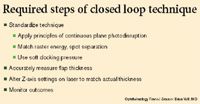Article
Novel technique enables ultra-thin flap creation
A novel technique using the 60-kHz femtosecond laser (IntraLase FS, Advanced Medical Optics) with modified settings and soft docking has been used routinely to create planar flaps thinner than 100 ?m.

Key Points
San Diego-Using a carefully designed technique involving modified laser settings, the 60-kHz femtosecond laser (IntraLase FS, Advanced Medical Optics) can be used to create ultra-thin flaps safely and consistently, said Brian Will, MD, here at the annual meeting of the American Society of Cataract and Refractive Surgery.

Getting thinner
"My flap creation technique has allowed patients with thin corneas and higher corrections to undergo LASIK safely with excellent visual outcomes and no increased risk of flap complications," he said. "Flap dissection from the stromal bed has been similar to thicker flaps created using more conventional laser settings, and visual acuity consistently has been 20/30 or better on day 1 after surgery."
According to Dr. Will, the primary challenges to ultra-thin flap creation with the femtosecond laser include variations in cone manufacture, differences in calibration technique between factory field service engineers, and a general lack of appreciation among surgeons of the influence of laser energy settings and docking technique on flap thickness. His closed loop process involves four steps: 1) standardization of technique and laser settings, 2) accurate measurement of flap thickness outcomes using optical coherence tomography (OCT), 3) adjustment of laser Z-axis settings based on actual versus intended thickness, and 4) intraoperative monitoring to define safety thresholds.
Dr. Will noted he uses the soft docking technique that he described in 2002 with a raster pulse energy of 1.2 μJ and a spot and line separation of 8 μm. Other laser settings are possible, with smaller spot and line separations likely to be more desirable. He indicated, however, that the key factor for the surgeon is to use the continuous plane photodisruption technique that he described in 2004.
"The femtosecond shock wave will always cause tissue fracture along the path of least resistance. When creating very thin flaps, continuous plane photodisruption is important because we want the interface to be the path of least resistance, not Bowman's membrane. Carefully matching pulse energy to spot separation to optimize the dissection of the collagen lamellae markedly reduces the chance of Bowman's membrane rupture," he commented.
Measuring outcomes
For measuring flap thickness outcomes, Dr. Will said he uses OCT with multiple measurements while in the "rainbow" mode for precise flap imaging.
"It is imperative that the surgeon use OCT because you simply cannot perform this technique prepositioning ultrasound methods because the results of the measurement have more noise error than exists in the flap measurement itself," he noted.
Then he adjusts the laser based on differences found between achieved versus expected flap thickness by modifying the Z-axis software adjustment or, if needed, the Z-axis internal calibration.
"Typically, Z-axis calibration is performed by cutting collagen gel, measuring the result using a micrometer, and then programming the laser using a bias toward thicker rather than thinner flaps," he said. "However, the consistent creation of thin flaps requires that the surgeon directly measure flap thickness outcomes using OCT in a large number of eyes that have undergone flap creation using the same laser settings.
Newsletter
Don’t miss out—get Ophthalmology Times updates on the latest clinical advancements and expert interviews, straight to your inbox.




